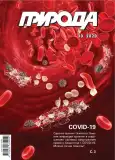Sledstviya stolknoveniya, porodivshego Lunu: traektorii oskolkov
- Авторлар: Byalko A.V.1, Kuzmin M.I1
-
Мекемелер:
- Шығарылым: № 10 (2020)
- Беттер: 31-39
- Бөлім: Articles
- URL: https://journals.eco-vector.com/0032-874X/article/view/631077
- DOI: https://doi.org/10.7868/S0032874X2010004X
- ID: 631077
Дәйексөз келтіру
Аннотация
The Moon was formed as a result of the Giant collision (Big Splash) of Proto-Earth with a planet called Theia. The debris of this event, scattered far from the Earth, return to a narrow region of the Solar System near the point of Giant Collision. Since the Earth itself also returns to this point every year, the falling of debris on our planet during the first thousand years after the collision is quite likely. A heavy early bombardment of the Earth and the Moon delivered to the planet water and those gases that were eliminated via a very strong heating during the Giant collision. This is the way of the Earthв„ўs atmosphere and ocean formation. We have clarified many details of these events; in particular, we have estimated the probability of debrisfalling not only on the Earth, but also on Mars and Venus. The article presents calculations of various trajectories of debris formed in the Collision,obtained by numerically solving the three-body problem. In prospect, we are going to discuss the evolution of the debris in different orbits and consequences of their falls to the Earth.
Әдебиет тізімі
- Canup R.M., Asphaug E. Origin of the Moon in a giant impact near the end of the Earth’s formation. Nature. 2001; 412: 208–812.doi: 10.1038/35089010.
- Бялко А.В., Кузьмин М.И. Осколки образования Луны: геофизические следствия Гигантского столкновения. ЖЭТФ. 2019;156(4): 603–614. [Byalko A.V., Kuzmin M.I. Fragments of the Moon formation: geophysical consequences of the Giant Impact. J. Exp.Theor. Phys. 2019; 129: 511–520. doi: 10.1134/S1063776119100182.]
- Amelin Y., Iizuka T., Kaltenbach A. et al. U–Pb chronology of the Solar System’s oldest solids with variable 238U/235U. Earth and Planetary Science Letters. 2010; 300: 343–350. doi: 10.1016/j.epsl.2010.10.015.
- Connelly J.N., Bizzarro M., Krot A.N. et al. The absolute chronology and thermal processing of solids in the solar protoplanetary disk.Science. 2012; 338: 651–655. doi: 10.1126/science.1226919.
- Zwart S.F.P. The lost siblings of the Sun. Astrophysical Journal. 2009; 696: L13–L16. doi: 10.1088/0004-637X/696/1/L1.
- Gaspar A., Rieke G.H. New HST data and modeling reveal a massive planetesimal collision around Fomalhaut. Proceedings of the National Academy of Sciences. 2020; 117: 9712–9722. doi: 10.1073/pnas.1912506117.
- Condie K.C.Earth as an evolving Planetary System. Third edition. Elsevier, 2015; pp 430.
- Кузьмин М.И., Ярмолюк В.В., Котов А.Б. Ранняя эволюция Земли, начало ее геологической истории: как и когда появилисьгранитоидные магмы. Литосфера. 2018; 5: 653–671. [Kuzmin M.I., Yarmolyuk V.V., Kotov A.B. The early evolution of the earth, the beginning of its geological history: how and when the granitoid magmas appeared. Lithosphere. 2018; 5: 653-671. (In Russ.).]doi: 10.24930/1681-9004-2018-18-5-653-671.
- Harrison T.M., Schmitt A.K., McCulloch M.T., Lovera O.M. Early (N = 4.5 Ga) formation of terrestrial crust: Lu–Hf, d18O and Ti thermometry results for Hadean zircons. Earth Planet. Sci. Lett. 2008; 268: 476–486. doi: 10.1016/j.epsl.
- Canup R.M. Simulations of a late lunar-forming impact. Icarus. 2004; 168: 433–456.
- Hollabaugh M., Everhart E. Earth horseshoe orbits. Astrophysical Letters. 1973; 15: 1–6.
- Бялко А.В. Зодиакальный свет: старая проблема и новые гипотезы. Природа. 2020; 6: 22–31. doi: 10.7868/S0032874X20060034.[Byalko A.V. Zodiacal light: an old problem and new hypotheses. Priroda. 2020; 6: 22–31. (In Russ.).]
- Ku Y., Jacobsen S.B.Potassium isotope anomalies in meteorites inherited from the protosolar molecular cloud. Science Advance. 2020;6: 1–10. doi: 10.1126/sciadv.abd0511.
Қосымша файлдар










